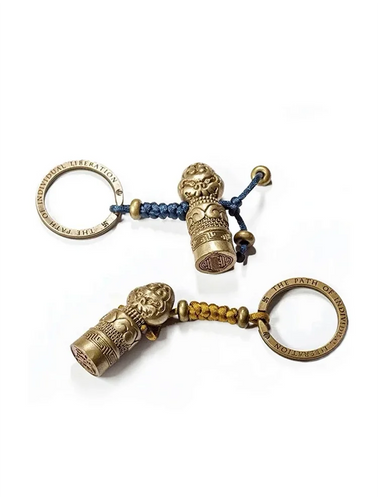
Heart-shaped seal pendant | Pure brass home protection and attracting wealth Vajra knot keychain
Click here to buy this keychain


The origin of ancient seals in Tibet is not recorded in history. From the 7th century AD, after the Tubo unified Tibet and managed a vast territory, the use of ancient seals was confirmed in many documents for issuing orders and commands. The seals that have been passed down to this day have a majestic and simple style, becoming silent witnesses of history. The symbolism of the seals not only represents "all", but also serves as a token of trust and commitment. We are trying to give new life to an ancient seal and have named it "Heart Seal".


Kritimukha
The seal button pattern "Face of Glory" (Kritimukha) in the Tibetan area is known as "Ziba" and in Chinese as "Tapini Beast". It is a creature with sharp antennae, prominent eyes, and a large mouth. In Sanskrit, Kriti means "honor" and Mukha means "mask". It has a dual meaning of protecting the home and attracting wealth, playing the role of a protective deity.
The Face of Glory is first recorded in the Indian Hindu book "Shiva Purana", and it has since been absorbed by Hindu Tantra and Buddhist Tantra. Its symbolism of subduing demons and promoting prosperity continues to the present day.

Two Types

"Embrace all things" Type
Two flying birds, returning with the mountains
True tranquility of the heart is not innate
It is the self-contained heart that does not follow external circumstances
Without inner peace
There is no outer peace
Only by embracing all things can one let go of attachment.

The seal markings are in Tibetan script with the word " སེམས " meaning "heart, heart nature," accompanied by the Chinese character for "heart" and a pattern of birds returning to the mountains, all in combination with a handmade yellow cord Vajra knot.


"Bajsibabe Script" Type
Bajsibabe, the fifth generation ancestor of the Sakya sect of Tibetan Buddhism in 1253 AD, was summoned by Kublai Khan to confer Buddhist precepts on Kublai Khan and his wife and twenty-five others. He was revered as the "national preceptor" and appointed as the leader of the Central Plains, leading the religious teachings throughout the empire. During the Yuan Dynasty, Bajsibabe was tasked with creating a new Mongolian script based on ancient Tibetan script, which was officially implemented in 1269 and known as the "Mongolian New Script" or "Mongolian Script," commonly referred to as the "Bajsibabe Script." Since then, official correspondences from the Tibetan region seeking to strengthen connections with the outside world were mostly written in the Bajsibabe Script.

The seal is stamped with the Tibetan script " སེམས " meaning heart or mind. It is paired with a handcrafted indigo-colored cord and a Vajra knot.

Product Information


The Tibetan script on the keychain, means "the path to personal liberation" in English.

The other side of the keychain is engraved with English words: THE PATH OF INDIVIDUAL LIBERATION

Vajra knot
We use yellow and blue jade threads to hand-knit the Vajra knot, hoping to reduce obstacles and bring good fortune.

